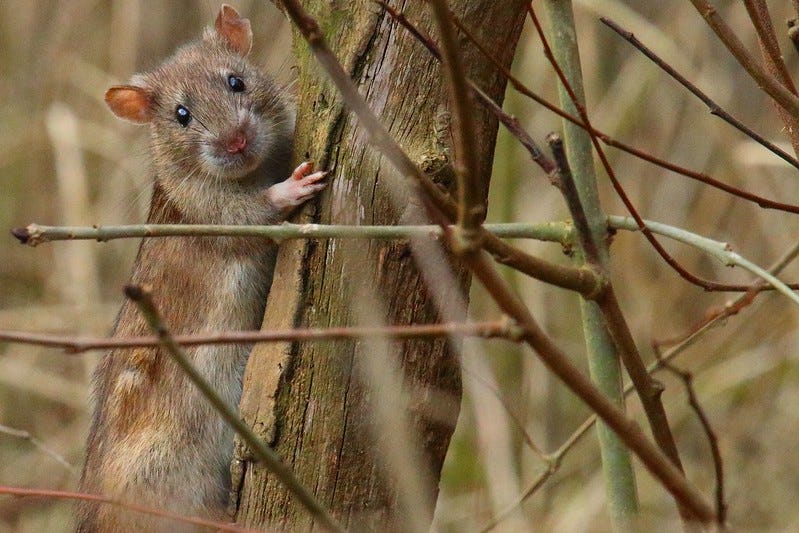Rats!
On living alongside them and keeping them at bay
It took a while for the rats to find us. When we bought our first chicken coop from a local company who made and sold them on Craigslist, the structure was deposited directly onto the ground. I thought enough about potential predators that might dig under the coop to put a small apron of galvanized wire around it. What I didn’t consider were the rats.
For the first two years of hen-keeping, it was blissful. The chickens were protected from the elements and other creatures who might want to get inside the cozy coop. They had a hanging feeder that I left their layer pellets in 24/7. Because their coop was connected to the run, I didn’t even have to wake up early to let them out. Then, one fateful day, I noticed the food was disappearing faster than usual. My dog saw the rats before I did. Holes started appearing in the dirt next to the coop. Her paws dug furiously until she uncovered pre-built tunnel systems running underground—and the rats running through them.
I already stored the chicken food and treats in galvanized metal bins beside the coop but the feeder was too much of a draw for the rats to ignore it. I began putting it away at night but it was too late. Now they knew we were there and had built freeways with off-ramps right into the coop. There were a few solutions. Making sure food was put away at night was one of them but chickens are messy creatures who love nothing more than to use their beaks to scrape food onto the ground. Natural methods like spraying mint around the coop, even if mildly annoying to the rodents, weren’t enough to stop them. You can always turn to pesticides, a euphemism for a product that causes mass murder, but that can lead to issues for animals like our dogs or local raptors who might eat the dead rats and get poisoned by accident. But because the rats keep breeding, you have to keep killing them on and on forever. (The only way to stop a rodent infestation is to kill or remove every single animal until only non-pregnant members of the same sex—who can’t breed—are left.) Even where rats are concerned, I’m not comfortable with that much death.
Mechanical traps are hard when you have dogs and free-ranging chickens like Emmylou who are only slightly larger than a rat and could just as easily be injured by them. The rats looked at the bucket trap I made and laughed. Deep into the hole of rat-repelling research, I discovered a new product that was essentially rodent birth control. Excited to try a method of population control that didn’t rely on killing, I ordered some. While it’s reportedly had success in many major cities, it didn’t do much in my yard. As far as I could tell, the rodents never touched a drop.

The only way to stop them from coming, it seemed, was to move. Luckily my husband and I could remain in our home but the chickens required new accommodations. I began planning a new coop, one built like a fortress to protect the flock from anything coming from the sky, the sides, or underground. There will be a new treadle feeder that should keep the chickens from spilling so much food on the ground and stop any rodent from accessing it overnight. The whole thing is built on a foundation of galvanized wire and four inches of gravel. Yet, as my contractor gently informed me, “You know there’s not really such a thing as ‘rat proof’ right?”
I did. They’re smart creatures. It’s part of why we dislike them so much and how they get to be such a nuisance. (Science writer Bethany Brookshire recently published a great book called Pests: How Humans Create Animal Villains that talks about our troubled relationship with species like rats.) Before my contractor started building, he worked in pest control. You may or may not know this but most rat poisons these days don’t work by killing the rats outright. If rats see their buddy take a nibble from a food item and promptly drop dead, they won’t be stupid enough to eat any of it and will pass the information on to their other rat friends. In the 1940s and 50s, a Wisconsin chemist named Karl Paul Link figured out how to develop the product that would become known as Warfarin which was used in medicine to stop blood clots even as a high-enough dose in rats would cause the animals to bleed internally.
My contractor told me that rats learned if they ate dog food, (which just happened to contain a lot of Vitamin K, the antidote to warfarin poisoning), they’d live. In other words, human settlements were both rat restaurant and pharmacy. I couldn’t find anything to back this account up but I believe it. Rats are just that smart. Either way, eventually the rats developed an immunity to Warfarin which led to so-called “second generation” anticoagulants which are more effective and also more dangerous to animals who eat rats that have been killed by it. There’s evidence to suggest rodents are becoming immune to these newer poisons too. Killing rats is just drawing out a war when it seems clear that, eventually, the rodents will win.
People say that keeping chickens attracts rats and that’s partially true. Rats love a buffet as much as the next animal and if you put food out for livestock of any kind—or feed cats or dogs outside—they will come. Yet they only show up at our coops because rats are probably already in your neighborhood, especially if you live in a city or suburb. Famously, there are no rats in Alberta, Canada thanks to a 70-year war on the species and some helpful geographical features. (One of my favorite podcasts, 99% Invisible did a great episode about this story.) But they’re almost everywhere else.

Rats are simply too good at doing what they do for us to get rid of them entirely. I can’t fault them for being so successful. The best we can do is keep their populations at a level where we can both go on with our lives blissfully unconcerned at the others’ existence. This means doing what we can to “rat proof” our homes, coops, barns, or any other place we really don’t want rats to become regulars—even if that really means just making them “rat resistant”.
At the very least, this new coop will do a better job than my current one of keeping rodents at bay. This is just attempt number two. By the time I get to my fourth or fifth coop, I’m sure I’ll have some really good tricks up my sleeve. It’s as true in rodents as it is in sports: The best offense is a good defense.
News from the Coop
Somehow my book is only two and a half months from publication? It feels like since the new year, Under the Henfluence went from something that was very far off into the future to something on the horizon. My goal is to get the chickens moved into their coop before I start doing book events so they can have more room and my husband will have slightly fewer animal chores when I’m away. Unfortunately, it’s winter and rains a lot in the Pacific Northwest so things are moving slowly. In addition to fun projects like stenciling and building nest boxes and perches, we still have to finish the lingering rock wall and I have to somehow fill the run with a few inches of sand. Their new run will be 16’ x 6’ which is, it turns out, a lot of sand to install one wheelbarrow at a time. In case spending so much time writing about chickens wasn’t a tip off, I love my flock very much.
Thanks so much to everyone preordering my book! (Please preorder my book so I can pay for all this sand.) It’s something that shows bookstores there’s demand for a book and can help build ~buzz~ all of which is very helpful for a first time author. I’ll be announcing a full event list for the book soon and hope anyone local will be able to come and say hello and talk chickens with me. Until then, here’s a little graphic I made of things you can do—most of them free—that support my book and other books you love!
If you need a chicken fix before the next newsletter, you can follow me on Twitter or Instagram.
If you liked this email, please share the newsletter with a chicken or animal lover in your life! As always, email me at underthehenfluence@gmail.com with any tips or comments. See you next month.




Some dog breeds are really good hunters. We had one that was lethal to rats, yet he didn't ever receive any training. He also learned to respectfully coexist with our cats!
I don't know much about animals (or anything in general!), but I think my dog was a relative of the Border Collie, only this was all-black. May be a good "green" solution!